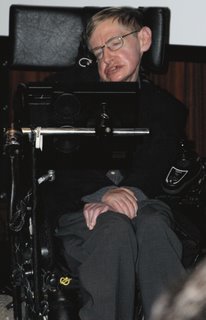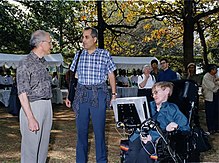Stephen Hawking was born on 8 January 1942 to Dr. Frank Hawking, a research biologist, and Isobel Hawking. He had two younger sisters, Philippa and Mary, and an adopted brother, Edward. Though Hawking's parents were living in North London, they moved to Oxford while his mother was pregnant with Stephen, desiring a safer location for the birth of their first child. (London was at the time by the Luftwaffe.) According to Hawking, a German V-2 missile struck only a few streets away.
After Hawking was born, the family moved back to London, where his father headed the division of parasitology at the National Institute for Medical Research. In 1950, Hawking and his family moved to St Albans, Hertfordshire, where he attended St Albans High School for Girls from 1950 to 1953. (At that time, boys could attend the Girls' school until the age of ten.) From the age of eleven, he attended St Albans School, where he was a good, but not exceptional, student. When asked later to name a teacher who had inspired him, Hawking named his mathematics teacher Dikran Tahta. He maintains his connection with the school, giving his name to one of the four houses and to an extracurricular science lecture series. He has visited it to deliver one of the lectures and has also granted a lengthy interview to pupils working on the school magazine, The Albanian.
Hawking was always interested in science. Inspired by his mathematics teacher, he originally wanted to study the subject at university. However, Hawking's father wanted him to apply to University College, Oxford, where his father had attended. As University College did not have a mathematics fellow at that time, it would not accept applications from students who wished to read that discipline. Hawking therefore applied to read natural sciences, in which he gained a scholarship. Once at University College, Hawking specialised in physics. His interests during this time were in thermodynamics, relativity, andquantum mechanics. His physics tutor, Robert Berman, later said in The New York Times Magazine:
It was only necessary for him to know that something could be done, and he could do it without looking to see how other people did it. [...] He didn't have very many books, and he didn't take notes. Of course, his mind was completely different from all of his contemporaries.
Hawking was passing, but his unimpressive study habits resulted in a final examination score on the borderline between first and second class honours, making an "oral examination" necessary. Berman said of the oral examination:
And of course the examiners then were intelligent enough to realize they were talking to someone far more clever than most of themselves.
After receiving his B.A. degree at Oxford in 1962, he stayed to study astronomy. He decided to leave when he found that studying sunspots, which was all the observatory was equipped for, did not appeal to him and that he was more interested in theory than in observation. He left Oxford for Trinity Hall, Cambridge, where he engaged in the study of theoretical astronomy and cosmology.
Science:-
Research fields
Hawking's principal fields of research are theoretical cosmology and quantum gravity.
In the late 1960s, he and his Cambridge friend and colleague, Roger Penrose, applied a new, complex mathematical model they had created from Albert Einstein's theory of general relativity.[20] This led, in 1970, to Hawking proving the first of many singularity theorems; such theorems provide a set of sufficient conditions for the existence of a gravitational singularity in space-time. This work showed that, far from being mathematical curiosities which appear only in special cases, singularities are a fairly generic feature of general relativity.
He supplied a mathematical proof, along with Brandon Carter, Werner Israel and D. Robinson, of John Wheeler's no-hair theorem – namely, that any black hole is fully described by the three properties of mass, angular momentum, and electric charge.
Hawking also suggested upon analysis of gamma ray emissions that after the Big Bang, primordial mini black holes were formed. With Bardeen and Carter, he proposed the four laws of black hole mechanics, drawing an analogy with thermodynamics. In 1974, he calculated that black holes should thermally create and emit subatomic particles, known today as Bekenstein-Hawking radiation, until they exhaust their energy and evaporate.
In collaboration with Jim Hartle, Hawking developed a model in which the universe had no boundary in space-time, replacing the initial singularity of the classical Big Bang models with a region akin to the North Pole: one cannot travel north of the North Pole, as there is no boundary. While originally the no-boundary proposal predicted a closed universe, discussions with Neil Turok led to the realisation that the no-boundary proposal is also consistent with a universe which is not closed.
Along with Thomas Hertog at CERN, in 2006 Hawking proposed a theory of "top-down cosmology," which says that the universe had no unique initial state, and therefore it is inappropriate for physicists to attempt to formulate a theory that predicts the universe's current configuration from one particular initial state. Top-down cosmology posits that in some sense, the present "selects" the past from a superposition of many possible histories. In doing so, the theory suggests a possible resolution of the fine-tuning question: It is inevitable that we find our universe's present physical constants, as the current universe "selects" only those past histories that led to the present conditions. In this way, top-down cosmology provides an anthropic explanation for why we find ourselves in a universe that allows matter and life, without invoking an ensemble of multiple universes.
Hawking's many other scientific investigations have included the study of quantum cosmology, cosmic inflation, helium production in anisotropic Big Bang universes, large N cosmology, the density matrix of the universe, topology and structure of the universe, baby universes, Yang-Mills instantons and the S matrix, anti de Sitter space, quantum entanglement andentropy, the nature of space and time, including the arrow of time, spacetime foam, string theory, supergravity, Euclidean quantum gravity, the gravitational Hamiltonian, Brans-Dicke andHoyle-Narlikar theories of gravitation, gravitational radiation, and wormholes.
At a George Washington University lecture in honour of NASA's fiftieth anniversary, Hawking theorised on the existence of extraterrestrial life, believing that "primitive life is very common and intelligent life is fairly rare."
Copyright © 2011 wikipedia.com
Copyright © 2011 www.youtube.com All rights reserved


